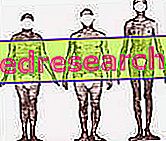Edited by Stefano Morini
Every day many people enroll in a trusting and at the same time ignorant and unaware of the sciences that will govern their future performances and results, they rely on instructors or in some cases the "guru" on duty and put in hand the management of their body in the hope that they will transform it or otherwise bring them closer to the body they have in mind.

That's why so many people rely on drugs (steroids and anoresizing agents) to speed up or reach their goal and claim that it is of course impossible to get results.
In reality there is a path (difficult and long) but one that is able to bring the individual to the maximum of the result that he can naturally pursue.
The science of biotypology and constitutional anthropology can really optimize a process of continuous improvement that passes through the various phases through initial assessments, plicometry, monitoring and metabolic estimates.
The various constitutional schools
There are many schools that have dealt with this complex and varied subject, some from the point of view of temperament and others from the physical and constitutional point of view, others still starting from the edogenic secretions of the glands and from nutrition.
We begin this summary summarized (listing them all would be impossible), of various schools and thoughts in Europe and in the world:
The French school with professors Bichat first and Jean Noel Halle then, described the temperaments in
Vascular, Muscular, Nervous and later enriched the concept with the inclusion of the type Bilioso, Sanguigno and Pitutitoso.
Later in 1908 to be precise, the French morphologist Sigaud distinguished the following individuals:
- Respiratory: characterized by the relative width of the trunk and the nose-malar area.
- Digestive: characterized by the prominence of the abdominal area, large mouth, thick lips, prominent jaws.
- Muscular: it is characterized by length of the limbs, rectangular trunk, large muscular masses and small heads.
- Cerebral: They have essentially a thin trunk, thin bone structure, delicate limbs, small body and large head.
There were many other theories such as that of the German anatomy professor Barke who simply divided the human being into two biotypes after carrying out various visceral anthropometric researches on corpses.
These were:
1) Fragile human type with hypoplastic organs
2) Large human type over-developed with large organs.
Teodoro Burgsch, another German, argued instead that the human body had to be framed based on factors called Indices of proportionality such as:
- body weight
- stature
- basin width
- upper and lower limb length
- relationship between thoracic perimeter and stature
Ernesto Kretsschemer, a psychiatrist, instead faced the complex relationship between the psychic and the bodily habitus, divided the physicists into:
- Athenian: thin or slender
- Athletic: muscular and proportionate
- Picnic: dense, thick, fat
- Displastic: rare type, accessory, abnormal.
In North America, however, Dr. Bryant identifies
- herbivorous type: characterized by low thyroid activity during growth
- carnivorous type: characterized instead by a hyperfunction of the thyroid which increases its longitudinal profiles more.
In Russia, instead, Saltikov and Ignatov identify four biotypes that are:
- Stenoplastico: (thoracic)
- Euriplastic: (short abdominal)
- Mesoplastic: (muscular)
- Subplastic: (uncommon type and not well defined)
But the best interpretation of the biotypes according to me and according to many authoritative experts is Sheldon's interpretation which essentially identifies three with a value scale to attribute.
Sheldon identifies:
- Ectomorph : essentially slender, frail, poor bone and muscle development and on a psychological level it can be classified as a cerebrotonic
- Mesomorphic : massive bony-muscular scaffolding, robust trunk, broad shoulders, hypertensive and proportionate limbs, on a psychological level it is considered as a somatotonic.
- Endomorphous : round and flaccid biotype, body height and width that often approach, abdomen prevails over thorax, short limbs. Psychologically it is a viscerotonic.
Obviously it would be almost impossible to frame a particular physicist in only one of these three categories, for this reason the value scale was invented:
NB: The determination of one's biotype must take place through various evaluation and measurement analyzes and above all carried out by experts in this method.
I repeat once again that biomorphological determination is essential to assign the work in the gym, the most suitable nutrition and the most efficient integration.
I would like to say a few words about the work in the gym that the various biotypes should do, given that we still hear about all the colors.
Assuming that a subject will be evaluated several times over time to determine whether the scale of membership has changed, the training must have the following average requirements:
ECTO-MESOMORFI WITH ECTOMORPHIC VALUES> 2.5 :Relations of polyarticular / monoarticular exercises 5/0, with time (years) they can reach 2/1
Many meals during the day, more carbo than protein.
Rather rich recoveries especially at the beginning
Relaxation or stretching techniques
MESOMORPH WITH ECTOMORPHIA VALUES <2.5:Report polyarticular / monoarticular exercises 4/1 and quickly to a 2/1, an agonist athlete even a 1/1
Medium volume rapidly increasing over time
Shorter recoveries especially over time
More protein and less carbohydrates
ENDO-Mesomorphs:Report exercises poly / mono = 2/1 at the beginning up to 1/2 later
At least 40% of the exercises must be of an aerobic nature
Hypolipidic, hypoglucidic, high-protein diet
Recoveries not very high
Concluding this article, I would like to remind you once again that these evaluations, accompanied by others of various kinds, are essential for optimizing the membership of a gym or a client of a personal trainer.
Neglecting all this means spending money and time unnecessarily and should create some doubts about the level of preparation of your coach.
SEE ALSO: The somatotype, endomorphic, mesomorphic, ectomorphic



